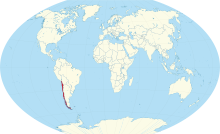| Paposoa | |
|---|---|
 | |
| Scientific classification | |
| Kingdom: | Plantae |
| Clade: | Tracheophytes |
| Clade: | Angiosperms |
| Clade: | Monocots |
| Order: | Asparagales |
| Family: | Amaryllidaceae |
| Subfamily: | Amaryllidoideae |
| Tribe: | Hippeastreae |
| Subtribe: | Traubiinae |
| Genus: | Paposoa Nic.García |
| Species: | P. laeta |
| Binomial name | |
| Paposoa laeta (Phil.) Nic.García | |
 | |
| It is endemic to Chile [1] | |
| Synonyms [2] | |
List
| |
Paposoa laeta is the only species of the monotypic genus Paposoa in the family Amaryllidaceae endemic to northern and central Chile. [3]